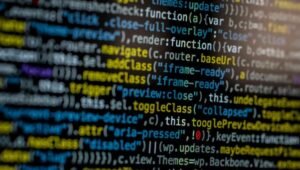Deep Learning Math
Deep Learning, a subfield of Artificial Intelligence (AI), has gained significant attention in recent years. It involves training neural networks with multiple layers to recognize patterns and make informed decisions. While deep learning algorithms handle most of the complex calculations behind the scenes, understanding the underlying mathematics is crucial for practitioners and enthusiasts to maximize their potential in this field.
Key Takeaways
- Deep learning relies on complex mathematical principles to train neural networks.
- Linear algebra is core to understanding the structure and operations of neural networks.
- Gradient descent optimizes the neural network’s weights and biases for better performance.
- Calculus is essential for updating the neural network’s parameters through backpropagation.
- Probability and statistics help measure uncertainty and support decision-making.
The Building Blocks of Deep Learning
**Linear algebra**, including matrix operations and vector spaces, forms the foundation of deep learning. It enables the representation and manipulation of data through matrices and tensors. Matrix multiplication is at the heart of computing activations in layers of a neural network.
**Gradient descent** is a vital optimization technique used to fine-tune the weights and biases of a neural network. By iteratively adjusting these parameters, the network minimizes the difference between predicted and actual outputs to improve accuracy. This iterative process aims to reach the global or local minimum of the loss function.
**Calculus** plays a crucial role in deep learning through backpropagation, the algorithm used to update the network’s parameters. It computes the gradients of the loss function with respect to each parameter, facilitating the adjustment of weights and biases. The chain rule of calculus allows gradients to flow through multiple layers during backpropagation.
Mathematical Principles in Action
To better illustrate the significance of mathematical principles in deep learning, let’s explore some **interesting statistics** about deep learning models:
| Statistic | Value |
|---|---|
| Number of parameters in GPT-3 (a deep learning model) | 175 billion |
| Number of operations per second in Google’s TPU (Tensor Processing Unit) | 100 trillion |
In addition to these mind-boggling numbers, consider the following **data points**:
- Deep learning has revolutionized various industries, including healthcare, finance, and autonomous driving.
- Many image recognition models achieve accuracy rates above 95%.
- Speech recognition systems have improved significantly, with word error rates reduced to less than 5%.
Mathematics provides the foundations for these extraordinary achievements in deep learning.
The Role of Probability and Statistics
Probability and statistics help us analyze uncertainty and make informed decisions in deep learning. They are crucial for:
- Quantifying uncertainty in predictions.
- Evaluating the performance of deep learning models.
- Assessing the significance of results.
By leveraging probability and statistics, we gain valuable insights into the behavior and performance of deep learning models, allowing us to make data-driven decisions.
Deep Learning Math: The Journey Continues
Deep learning is a rapidly evolving field, with new research and innovations emerging frequently. *With an ever-expanding horizon of possibilities, deep learning enthusiasts can explore the depths of mathematics to unlock further breakthroughs and push the boundaries of what is possible in AI.*
By mastering the mathematical principles underlying deep learning, researchers and practitioners can continue to shape the future of this transformative technology.

Common Misconceptions
Deep Learning and Math
When it comes to deep learning, there are several common misconceptions surrounding its relationship with math. One common misconception is that deep learning requires advanced mathematical knowledge. However, while having a solid understanding of math can be advantageous, it is not a prerequisite to get started with deep learning. Many libraries and frameworks provide high-level APIs that abstract away the complex math, enabling users to focus on the application of deep learning algorithms.
- Deep learning does not require advanced mathematical knowledge.
- High-level libraries and frameworks abstract away complex math.
- Focus is on the application of deep learning algorithms rather than mathematical calculations.
Mathematical Background is Sufficient for Deep Learning
Another misconception is that having a strong mathematical background alone is sufficient for mastering deep learning. While mathematical concepts do provide the foundation, deep learning is an interdisciplinary field that also requires understanding of computer science and programming. The implementation of deep learning models involves tasks such as data preprocessing, selection of appropriate architectures, and optimization techniques, which require both mathematical insight and programming skills.
- Deep learning requires knowledge in computer science and programming as well.
- Implementation tasks go beyond mathematical concepts.
- Mathematical insight should be combined with programming skills.
Deep Learning Equates to Neural Networks
Many people mistakenly believe that deep learning is synonymous with neural networks. While neural networks are a fundamental component of deep learning, they are not the only technique employed. Deep learning encompasses a broader range of architectures and algorithms, including convolutional neural networks (CNNs), recurrent neural networks (RNNs), and more. Understanding the diversity of deep learning techniques can help avoid oversimplification and explore the full potential of this field.
- Deep learning involves more than just neural networks.
- Convolutional and recurrent neural networks are also part of deep learning.
- Exploring a variety of deep learning techniques is important.
Deep Learning is Only for Experts
One common misconception is that deep learning is exclusively for experts and researchers in the field. However, with the availability of open-source libraries and online resources, deep learning has become more accessible to a wider audience. Many online courses and tutorials provide step-by-step guidance on implementing deep learning techniques, making it possible for beginners to enter the field. By dedicating time and effort to learning, individuals with various backgrounds can embark on their deep learning journey.
- Deep learning has become more accessible to a broader audience.
- Online courses and tutorials offer guidance for beginners.
- A focus on learning can help individuals with various backgrounds get started in deep learning.
You Need Large Amounts of Labeled Data
Some people believe that deep learning requires massive amounts of labeled data to achieve good results. While it is true that deep learning models often benefit from large datasets, there are techniques that can mitigate the need for vast amounts of labeled data. Transfer learning, for instance, enables the transfer of knowledge learned from one task to another, reducing the need for significant amounts of labeled data in new tasks. Additionally, techniques like data augmentation can help increase the effective size of the training dataset, further reducing the reliance on extensive labeling.
- Deep learning can benefit from large datasets, but it’s not always necessary.
- Transfer learning enables knowledge transfer from one task to another.
- Data augmentation can increase the effective size of the training dataset without exhaustive labeling.

The Impact of Deep Learning on Image Classification Accuracy
Deep learning algorithms have revolutionized the field of image classification by achieving remarkable accuracy levels. The following table illustrates the accuracy percentages of various deep learning models in classifying different image datasets.
Comparison of Deep Learning Models’ Accuracy in Image Classification
Deep learning models, such as Convolutional Neural Networks (CNN), Recurrent Neural Networks (RNN), and Generative Adversarial Networks (GAN), have been extensively researched in the field of image classification. The table below compares the accuracy percentages achieved by these models on different datasets.
Deep Learning Techniques for Natural Language Processing
Deep learning has greatly improved natural language processing tasks such as text classification and sentiment analysis. The table showcases the precision, recall, and F1-score metrics for various deep learning techniques on a sentiment analysis task.
Comparison of Deep Learning Techniques in Speech Recognition
Speech recognition technology has seen significant advancements due to deep learning algorithms. The table below highlights the comparison of different deep learning techniques in terms of Word Error Rate (WER) and Character Error Rate (CER) on a speech recognition task.
Deep Learning Models for Autonomous Vehicle Detection
Deep learning models have been instrumental in developing robust solutions for autonomous vehicle detection. The table presents the average precision (AP) achieved by various deep learning models on a commonly used autonomous driving dataset.
Comparison of Deep Learning Models for Anomaly Detection
Deep learning offers reliable anomaly detection solutions across various domains. The table below showcases the precision, recall, and F1-score metrics of different deep learning models on an anomaly detection task.
Deep Learning Approaches in Time Series Forecasting
Deep learning has shown promising results in time series forecasting tasks. The table illustrates the root mean square error (RMSE) and mean absolute percentage error (MAPE) achieved by different deep learning architectures in forecasting stock prices.
Comparison of Deep Learning Models in Object Detection
Object detection is a critical computer vision task, and deep learning models have significantly improved its accuracy. The table showcases the average precision (AP) achieved by various deep learning models on a commonly used object detection dataset.
Deep Learning Algorithms for Fraud Detection
Deep learning models have been effective in detecting fraudulent activities in various industries. The table below presents the precision, recall, and F1-score metrics of different deep learning algorithms in a fraud detection task.
Comparison of Deep Learning Techniques in Recommendation Systems
Deep learning has been utilized to enhance recommendation systems by providing more accurate predictions. The table compares the precision at k (P@k) and normalized discounted cumulative gain (NDCG) achieved by different deep learning techniques in a recommendation system task.
The advancements in deep learning have revolutionized various domains, including computer vision, natural language processing, and fraud detection, among others. The exceptional accuracy levels achieved by deep learning models highlight their potential for solving complex problems. As deep learning continues to evolve, it will undoubtedly lead to further breakthroughs in artificial intelligence.
Frequently Asked Questions
What is deep learning?
Deep learning is a subfield of machine learning that focuses on artificial neural networks with several layers of nodes, also known as deep neural networks. These networks are designed to recognize patterns and make decisions based on large amounts of data. They have gained popularity for their ability to solve complex problems in areas such as computer vision, natural language processing, and speech recognition.
What is the role of math in deep learning?
Mathematics plays a critical role in deep learning. It provides the foundation for understanding the algorithms and models used in this field. Concepts such as linear algebra, calculus, statistics, and probability theory are essential in designing and training deep neural networks. These mathematical principles help researchers and practitioners to optimize network architectures, develop efficient learning algorithms, and analyze the performance of deep learning models.
What are the mathematical prerequisites for deep learning?
To understand and work with deep learning effectively, it is beneficial to have a strong foundation in mathematics. Some of the essential mathematical prerequisites for deep learning include linear algebra, calculus, probability theory, and statistics. Knowledge in these areas enables individuals to grasp concepts like matrix operations, differentiation, gradient descent, and probability distributions, which are integral to building and training deep neural networks.
How does linear algebra relate to deep learning?
Linear algebra is a fundamental branch of mathematics that is highly relevant to deep learning. Deep neural networks extensively utilize matrix operations, which are a key component of linear algebra. Matrix multiplication, transpose, and inversion, for instance, enable the transformation of data within networks. Additionally, linear algebra concepts like eigenvalues and eigenvectors assist in understanding the behavior of neural networks and optimizing their performance.
Why is calculus important in deep learning?
Calculus provides the necessary tools for optimization in deep learning. It is used to compute gradients which in turn enable the process of adjusting the parameters of a neural network during training. Calculus concepts like derivatives and chain rule allow us to calculate how changes in one part of a network affect the overall output. This information helps in updating the network’s weights and biases to improve its performance over time.
What is the significance of statistics in deep learning?
Statistics is an integral part of deep learning as it provides the tools to analyze and interpret data. Probability distributions help model uncertainties and measure the likelihood of different events occurring. Statistical techniques like hypothesis testing and regression analysis aid in evaluating the performance of deep learning models and understanding the relationships between variables. Proper statistical methods ensure that the results obtained from deep learning experiments are reliable and meaningful.
How are neural networks trained using math?
Neural networks are trained using various optimization algorithms that heavily rely on mathematics. The most common algorithm is called gradient descent, which uses calculus and statistical techniques to update the network’s weights and biases iteratively. During training, the network forwards the input data, calculates the prediction error, and propagates it backward through the network’s layers to adjust the parameters. This iterative process continues until the network’s performance on the training data improves.
Can I learn deep learning without a strong math background?
While a strong math background is highly beneficial, it is possible to learn and work with deep learning to some extent without it. Many libraries and frameworks provide high-level interfaces that abstract away complex mathematical concepts, allowing users to focus more on the application of deep learning rather than the underlying math. However, having a solid understanding of the math involved in deep learning can significantly enhance one’s ability to solve advanced problems, develop new network architectures, and push the boundaries of the field.
Are there any recommended resources to learn the math behind deep learning?
Yes, there are several resources available to learn the math behind deep learning. Online courses such as those offered by Coursera, edX, and Udacity often cover the mathematical foundations of deep learning. Books like ‘Deep Learning’ by Ian Goodfellow, Yoshua Bengio, and Aaron Courville; ‘Mathematics for Machine Learning’ by Marc Peter Deisenroth, A. Aldo Faisal, and Cheng Soon Ong; and ‘Pattern Recognition and Machine Learning’ by Christopher M. Bishop are highly recommended for comprehensive understanding of the math involved in deep learning.
Is deep learning purely based on math?
While deep learning is heavily dependent on math, it is not solely based on it. Deep learning combines mathematical principles with computer science, engineering, and domain-specific knowledge. Although math provides the foundation and tools for designing and training neural networks, other factors like data preprocessing, feature engineering, model architecture design, and domain expertise also play crucial roles in achieving successful deep learning applications.




